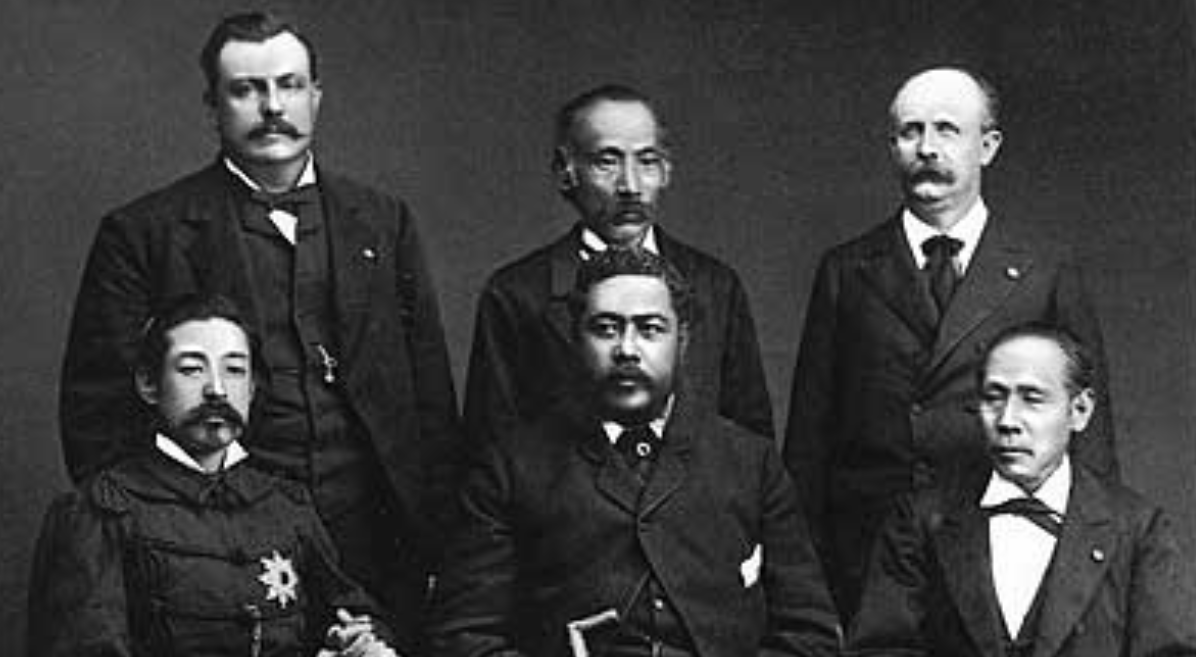
Kāhea: Holoana o Kalākaua!
Holoana o Kalākaua
E ʻimi i ka pono nā moku
I kahiki a hoʻi mai
I kahiki aʻo Pelekane
Mai kahiki a wāwae pahu
I ka ʻohe kaʻekeʻeke
I ka pahu kani a Lono
Lono i ka Makahiki
Hoʻoheihei kani moana
Kani Hāwea pahu aliʻi
Eo mai e ka lani
Kalākaua he inoa
Inoa: He inoa no Kalani Kāwika Kalākaua!
In 1881 Ka Lani Kāwika Kalākaua set sail on a ’round the world journey to establish ties with other nations and seek financial support for his tiny, but modern, kingdom. He left Honolulu on 20 January, headed for San Francisco. From there he traveled to Japan, arriving on 4 March at the Port of Yeddo (Tokyo). He was greeted with 21-gun salutes, the Emperor Meiji’s military band played the Hawaiian national anthem, and the streets were lined with people waving Hawaiian and Japanese flags. The Imperial Court hosted Kalākaua to lodging at the Palace of the Enryoukan. Kalākaua was hosted by the Emperor Meiji at the Imperial Palace.
Kalākaua had hoped to offer his niece, the Crown Princess Kaʻiulani, to Prince Sadamaro for marriage to strengthen ties with Japan. Sadamaro told Kalākaua that he already was engaged to be married. However, the two nations did sign an agreement to remove extraterritoriality claims from their treaty, which eventually facilitated Japanese labor immigration to Hawaii. On this visit, Kalākaua appointed Robert Walker Irwin, his Counsel General to Japan as Hawaiian Minister to the Japanese Court. Irwin subsequently negotiated the Government Kanyaku Imin immigration system and oversaw the legal immigration of nearly 30,000 Japanese nationals to Hawaii by 1894. After a brief visit to Kobe and Nagasaki, the King transferred to the steamer Tokio-maru headed for Shanghai, China on March 22nd.
The mele Holoana o Kalākaua talks about this circumnavigation of the world. It generally is listed as “traditional” with no named composer (It was not composed by Mark Kealiʻi Hoʻomalu). This probably means it originally was composed by a group of people who each contributed lyrics. This was, and remains, a popular pastime in Hawaiʻi.
The certain rights Kalākaua is seeking are trade agreements and an assurance of recognizing Hawaiian sovereignty. By Kalākaua’s time, the United States, Russia, France, and England all had tried to take over Hawaiʻi. France and Russia decided not to pursue Hawaiʻi and maintained peaceful relations. England did become an ally of Hawaiʻi. Business interests in the United States were trying to find ways to overthrow the Hawaiian Kingdom. So Kalākaua wanted to find allies around the world to help preserve his kingdom through trade and diplomatic support. He also was looking for loans, as the kingdom was heavily in debt.
At the time, no other head of state had traveled around the world, so he not only was the first, he was the fastest. The “wāwae pahu” is a reference to the drumming footbeats of runners in a footrace. The ʻohe kaʻekeʻeke was a popular musical instrument during his reign, and was used in many hula extolling Kalākaua.
Kalākaua began his voyage toward the end of the Makahiki season, sailing away like Lono, and like Lono, was expected to return the next year. He returned to Honolulu on 29 October 1881, at the beginning of the Makahiki season, just like Lono.
Hāwea is the name of a sacred royal drum brought to Hawaiʻi by Lonoikamakahiki.
